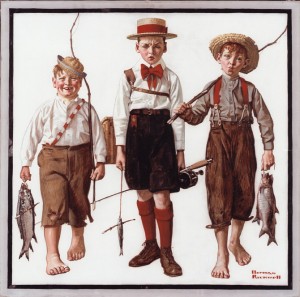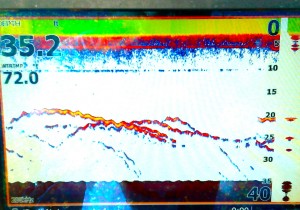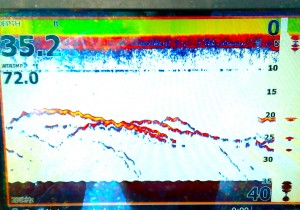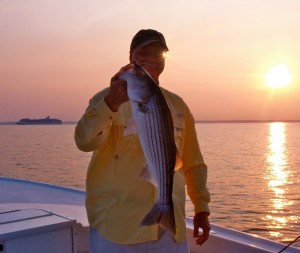suspended fish
 Been fishing lately? If you have, I bet you’ve noticed that there are a lot of suspended fish this time of year. There’s nothing more frustrating to Chesapeake Bay light tackle fishermen than to see nice marks on the fish finder, then not get bites. How do you catch those finicky suspended rockfish? Frankly, it’s tough, but there are some things you can do to increase your chances. To start, consider what’s going on below the surface.
Been fishing lately? If you have, I bet you’ve noticed that there are a lot of suspended fish this time of year. There’s nothing more frustrating to Chesapeake Bay light tackle fishermen than to see nice marks on the fish finder, then not get bites. How do you catch those finicky suspended rockfish? Frankly, it’s tough, but there are some things you can do to increase your chances. To start, consider what’s going on below the surface.
1. Scope Out The Situation – Stripers adjust their feeding habits depending on conditions. Since the Chesapeake Bay is an estuary, conditions can change frequently. Sometimes changes are short-term like those brought on by tides and currents. Sometimes, they last longer like with seasonal water-temperature adjustments. There are even cases where conditions can change for years at a time.
In the near-decade that I’ve been fishing the Chesapeake, I’ve noticed a change, particularly in the warmer months, to more fish feeding in temperate mid-level zones in open water. This can happen when the water conditions on the surface are not as comfortable as they are farther down. In the spring when we get a lot of rain, storm water runs off polluted roads, parking lots, fertilized lawns, and farmer’s fields resulting in a surface layer of unsalted, polluted water. Stripers will come up to feed in this layer when conditions are good and when they’re very hungry, but they’ll drop back down into the comfort zone when they aren’t extremely active. They usually won’t swim down deeper than forty feet or so because the water down deep may not hold enough oxygen, or the temperature or salinity can be uncomfortable for them. Read More!
 Suspended fish, I hate ‘em. Scattered fish suspending in deep water is one of the most difficult situations a light tackle angler will encounter on the Chesapeake Bay. In years past, I’ve refused to target suspended fish. I’d rather run fifteen additional miles looking for stripers feeding off the bottom than fool with the picky little snots. But, as Bob Dylan might say, The Times, They Are a Changin’. Bad water makes everything different. As predicted in my last entry, low oxygen levels have led to prolific algae blooms in the tributary rivers and in some areas of the main stem of the Bay. Conditions are worse around the western shore rivers since more people live there and there is more pollution.
Suspended fish, I hate ‘em. Scattered fish suspending in deep water is one of the most difficult situations a light tackle angler will encounter on the Chesapeake Bay. In years past, I’ve refused to target suspended fish. I’d rather run fifteen additional miles looking for stripers feeding off the bottom than fool with the picky little snots. But, as Bob Dylan might say, The Times, They Are a Changin’. Bad water makes everything different. As predicted in my last entry, low oxygen levels have led to prolific algae blooms in the tributary rivers and in some areas of the main stem of the Bay. Conditions are worse around the western shore rivers since more people live there and there is more pollution.
Pollution, especially nutrients like nitrates and phosphorus get into the Bay as a result of raw sewage dumping, storm-water runoff, and excessive fertilizer use. This makes the water very fertile, so small microscopic plants such as algae grow rapidly. The algae cells block sunlight, then die and sink to the bottom creating areas of low oxygen where fish can’t survive. Since dissolved oxygen levels were already at record lows this year, it didn’t take long for the blooming and decaying cycle to use up whatever oxygen was left. Read More!
 Channel catfish at Hackett’s Bar, carp at the Bay Bridge, snakeheads in St. Jerome’s Creek, and very few stripers in their usual haunts around Kent Island – what’s up with all this late-spring craziness in the Chesapeake Bay? Most fishermen are blaming salt, or more specifically, a lack thereof. Very wet weather in the Susquehanna River watershed has meant lots of fresh water entering the Bay. It’s highly unusual for the Bay to be this fresh in June. Some stations are reporting the lowest readings in recorded history. Salinity is expressed in parts per thousand (ppt), in other words, the number of grams of dissolved salts present in 1,000 grams of water. The water in the Atlantic Ocean is about 35 ppt. Surface salinity today at the Gooses Reef Buoy in the Mid-Chesapeake Bay is 2.0 ppt. That’s low! For better striped bass fishing, we need more salt.
Channel catfish at Hackett’s Bar, carp at the Bay Bridge, snakeheads in St. Jerome’s Creek, and very few stripers in their usual haunts around Kent Island – what’s up with all this late-spring craziness in the Chesapeake Bay? Most fishermen are blaming salt, or more specifically, a lack thereof. Very wet weather in the Susquehanna River watershed has meant lots of fresh water entering the Bay. It’s highly unusual for the Bay to be this fresh in June. Some stations are reporting the lowest readings in recorded history. Salinity is expressed in parts per thousand (ppt), in other words, the number of grams of dissolved salts present in 1,000 grams of water. The water in the Atlantic Ocean is about 35 ppt. Surface salinity today at the Gooses Reef Buoy in the Mid-Chesapeake Bay is 2.0 ppt. That’s low! For better striped bass fishing, we need more salt.
Fishermen have long recognized the importance of locating comfort zones where fish prefer to stay, but sometimes that isn’t so easy. Fishing in late May and early June is usually a challenge, but low salinity levels have made it especially difficult this year. Complicating the matter is that he water can be a lot saltier on the bottom of the Bay than it is on top this time of year. Since, in addition to surface observations, The Gooses Reef Buoy also provides salinity readings from the bottom of the Bay, we can see that it’s currently 7.1 ppt. That’s over three times saltier than it is on the surface. Read More!


